Nicholas P. Cheremisinoff. Handbook of Solid Waste Management and Waste Minimization Technologies
Подождите немного. Документ загружается.

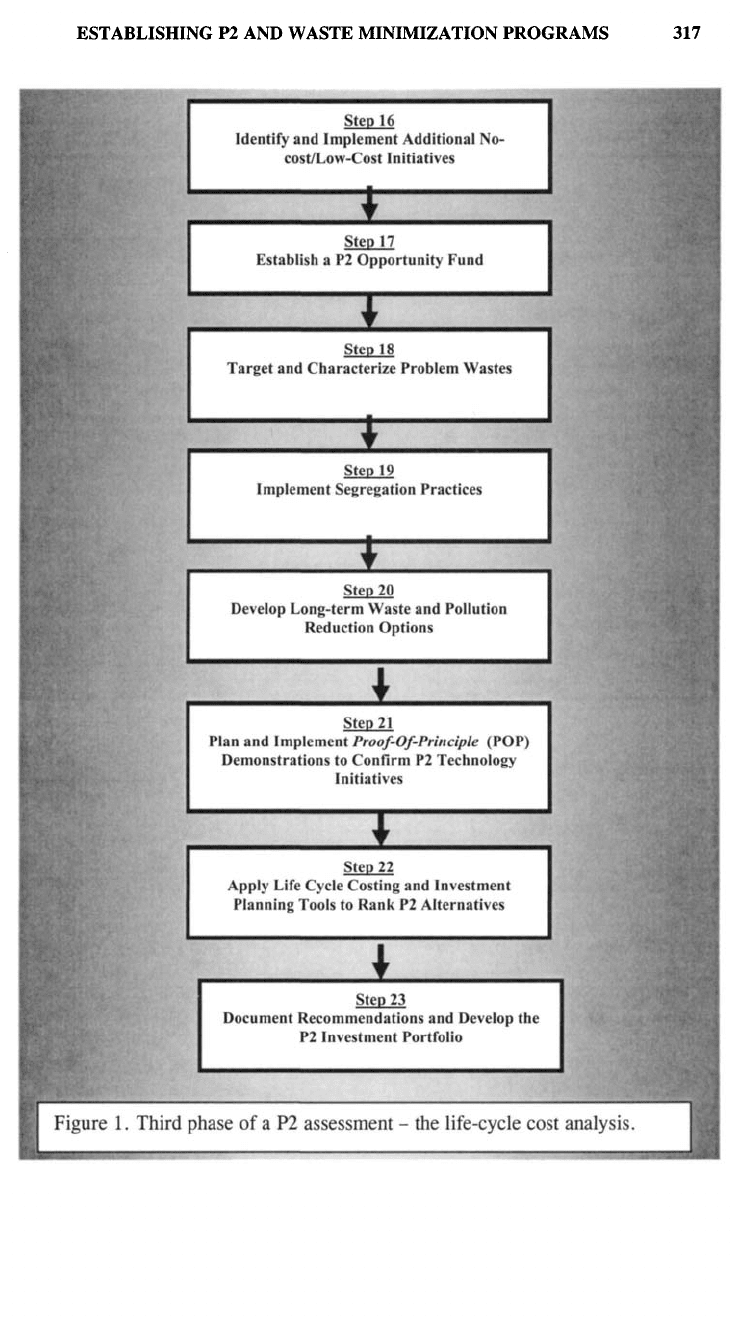
Step 16
Identify and Implement Additional No-
cost/Low-Cost Initiatives
Step 17
Establish a P2 Opportunity Fund
Step 18
Target and Characterize Problem Wastes
Step 19
Implement Segregation Practices
Step 20
Develop Long-term Waste and Pollution
Reduction Options
Step 21
Plan and Implement Proof-Of-Principle (POP)
Demonstrations to Confirm P2 Technology
Initiatives
Step 22
Apply Life Cycle Costing and Investment
Planning Tools to Rank P2 Alternatives
Step 23
Document Recommendations and Develop the
P2 Investment Portfolio
Figure 1. Third phase of a P2 assessment - the life-cycle cost analysis.
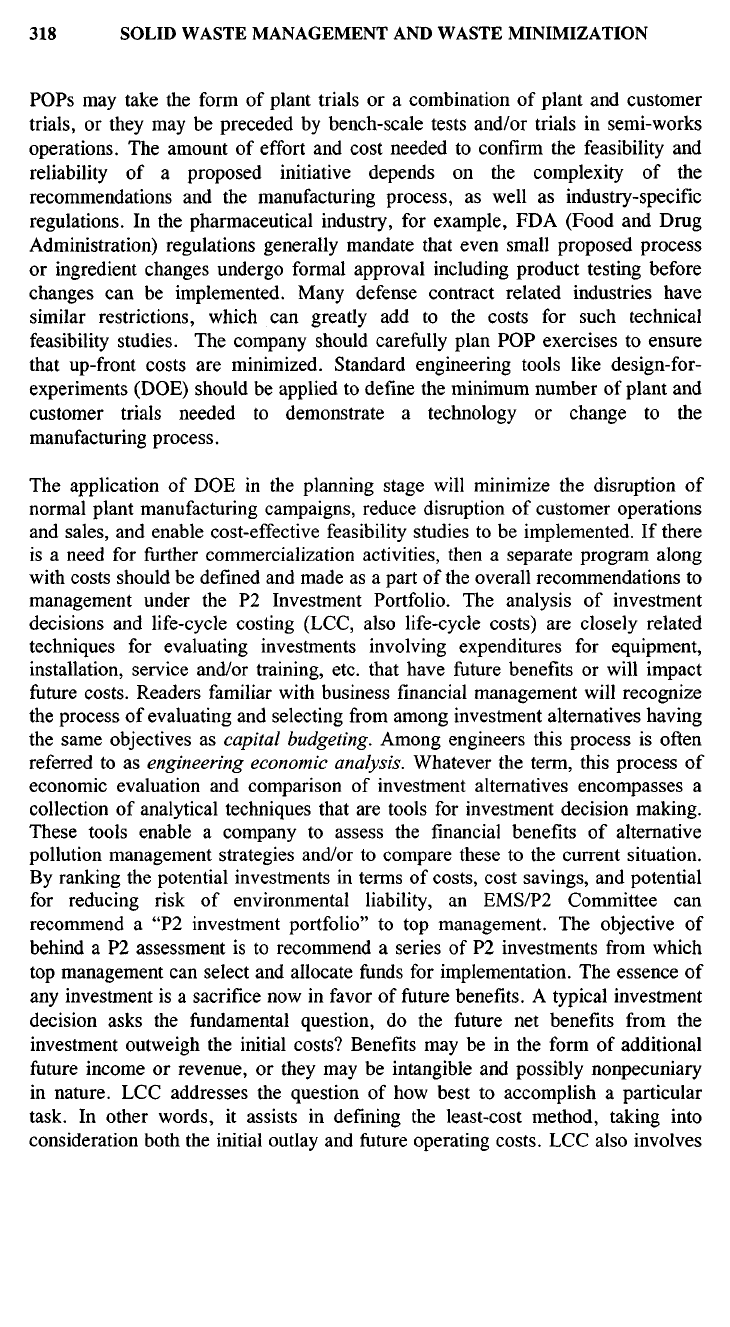
POPs may take the form of plant trials or a combination of plant and customer
trials,
or they may be preceded by bench-scale tests and/or trials in semi-works
operations. The amount of effort and cost needed to confirm the feasibility and
reliability of a proposed initiative depends on the complexity of the
recommendations and the manufacturing process, as well as industry-specific
regulations. In the pharmaceutical industry, for example, FDA (Food and Drug
Administration) regulations generally mandate that even small proposed process
or ingredient changes undergo formal approval including product testing before
changes can be implemented. Many defense contract related industries have
similar restrictions, which can greatly add to the costs for such technical
feasibility studies. The company should carefully plan POP exercises to ensure
that up-front costs are minimized. Standard engineering tools like design-for-
experiments (DOE) should be applied to define the minimum number of plant and
customer trials needed to demonstrate a technology or change to the
manufacturing process.
The application of DOE in the planning stage will minimize the disruption of
normal plant manufacturing campaigns, reduce disruption of customer operations
and sales, and enable cost-effective feasibility studies to be implemented. If there
is a need for further commercialization activities, then a separate program along
with costs should be defined and made as a part of the overall recommendations to
management under the P2 Investment Portfolio. The analysis of investment
decisions and life-cycle costing (LCC, also life-cycle costs) are closely related
techniques for evaluating investments involving expenditures for equipment,
installation, service and/or training, etc. that have future benefits or will impact
future costs. Readers familiar with business financial management will recognize
the process of evaluating and selecting from among investment alternatives having
the same objectives as capital budgeting. Among engineers this process is often
referred to as engineering economic analysis. Whatever the term, this process of
economic evaluation and comparison of investment alternatives encompasses a
collection of analytical techniques that are tools for investment decision making.
These tools enable a company to assess the financial benefits of alternative
pollution management strategies and/or to compare these to the current situation.
By ranking the potential investments in terms of costs, cost savings, and potential
for reducing risk of environmental liability, an EMS/P2 Committee can
recommend a "P2 investment portfolio" to top management. The objective of
behind a P2 assessment is to recommend a series of P2 investments from which
top management can select and allocate funds for implementation. The essence of
any investment is a sacrifice now in favor of future benefits. A typical investment
decision asks the fundamental question, do the future net benefits from the
investment outweigh the initial costs? Benefits may be in the form of additional
future income or revenue, or they may be intangible and possibly nonpecuniary
in nature. LCC addresses the question of how best to accomplish a particular
task. In other words, it assists in defining the least-cost method, taking into
consideration both the initial outlay and future operating costs. LCC also involves
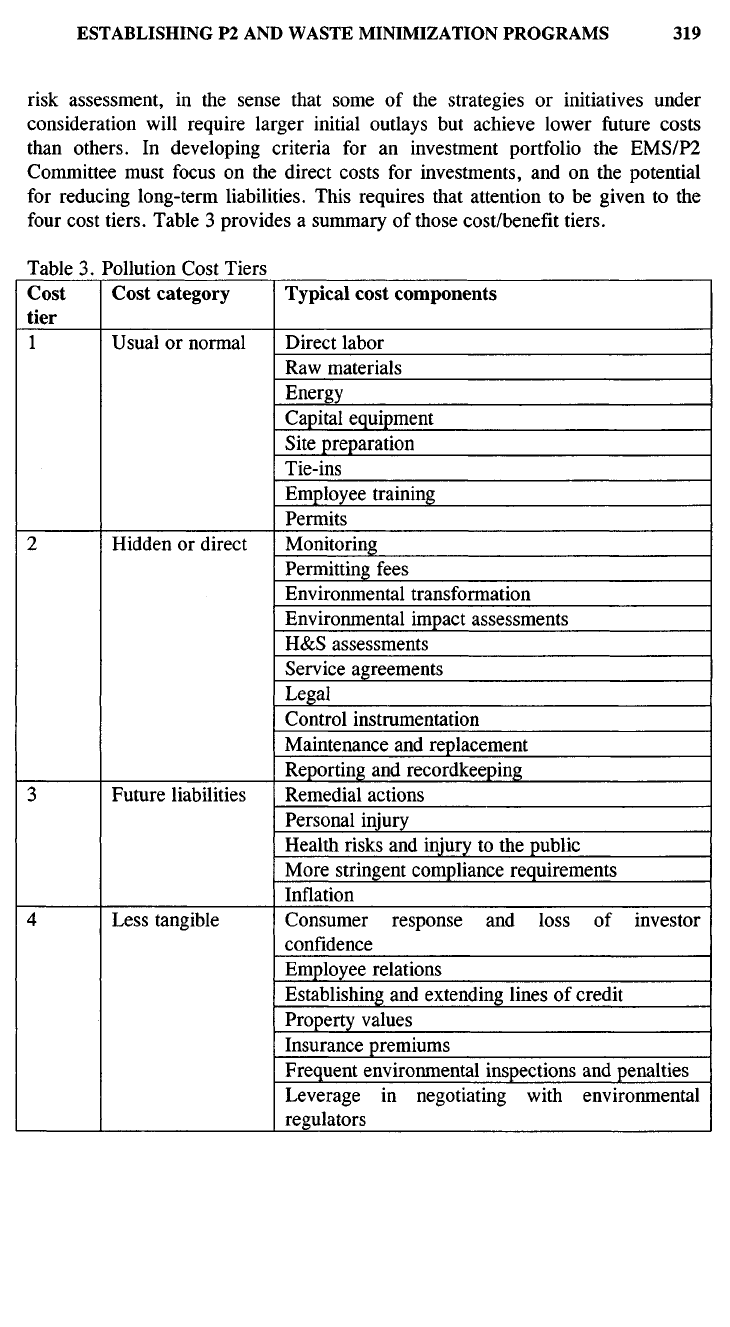
Table 3. Pollution Cost Tiers
Cost
tier
1
2
3
4
Cost category
Usual or normal
Hidden or direct
Future liabilities
Less tangible
Typical cost components
Direct labor
Raw materials
Energy
Capital equipment
Site preparation
Tie-ins
Employee training
Permits
Monitoring
Permitting fees
Environmental transformation
Environmental impact assessments
H&S assessments
Service agreements
Legal
Control instrumentation
Maintenance and replacement
Reporting and recordkeeping
Remedial actions
Personal injury
Health risks and injury to the public
More stringent compliance requirements
Inflation
Consumer response and loss of investor
confidence
Employee relations
Establishing and extending lines of credit
Property values
Insurance premiums
Frequent environmental inspections and penalties
Leverage in negotiating with environmental
regulators
risk assessment, in the sense that some of the strategies or initiatives under
consideration will require larger initial outlays but achieve lower future costs
than others. In developing criteria for an investment portfolio the EMS/P2
Committee must focus on the direct costs for investments, and on the potential
for reducing long-term liabilities. This requires that attention to be given to the
four cost tiers. Table 3 provides a summary of those cost/benefit tiers.
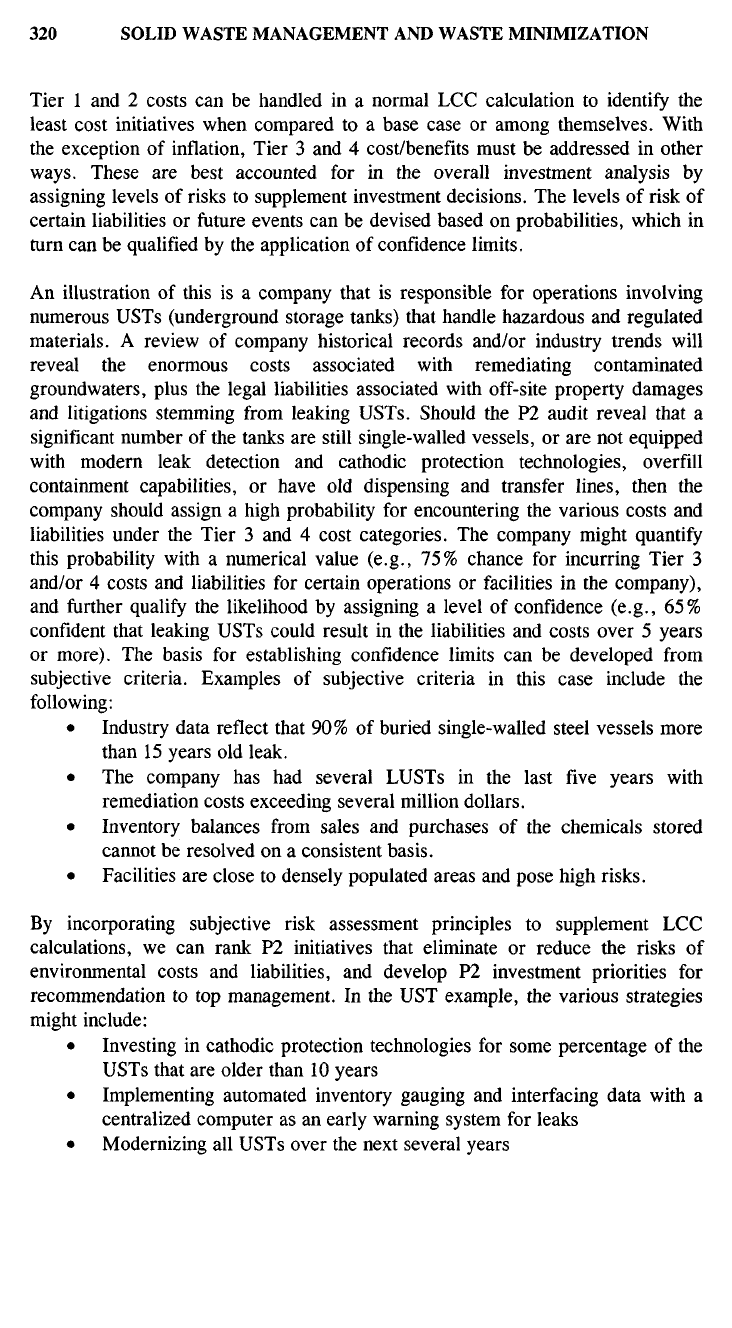
Tier 1 and 2 costs can be handled in a normal LCC calculation to identify the
least cost initiatives when compared to a base case or among themselves. With
the exception of inflation, Tier 3 and 4 cost/benefits must be addressed in other
ways.
These are best accounted for in the overall investment analysis by
assigning levels of risks to supplement investment decisions. The levels of risk of
certain liabilities or future events can be devised based on probabilities, which in
turn can be qualified by the application of confidence limits.
An illustration of this is a company that is responsible for operations involving
numerous USTs (underground storage tanks) that handle hazardous and regulated
materials. A review of company historical records and/or industry trends will
reveal the enormous costs associated with remediating contaminated
groundwaters, plus the legal liabilities associated with off-site property damages
and litigations stemming from leaking USTs. Should the P2 audit reveal that a
significant number of the tanks are still single-walled vessels, or are not equipped
with modern leak detection and cathodic protection technologies, overfill
containment capabilities, or have old dispensing and transfer lines, then the
company should assign a high probability for encountering the various costs and
liabilities under the Tier 3 and 4 cost categories. The company might quantify
this probability with a numerical value (e.g., 75% chance for incurring Tier 3
and/or 4 costs and liabilities for certain operations or facilities in the company),
and further qualify the likelihood by assigning a level of confidence (e.g., 65%
confident that leaking USTs could result in the liabilities and costs over 5 years
or more). The basis for establishing confidence limits can be developed from
subjective criteria. Examples of subjective criteria in this case include the
following:
• Industry data reflect that 90% of buried single-walled steel vessels more
than 15 years old leak.
• The company has had several LUSTs in the last five years with
remediation costs exceeding several million dollars.
• Inventory balances from sales and purchases of the chemicals stored
cannot be resolved on a consistent basis.
• Facilities are close to densely populated areas and pose high risks.
By incorporating subjective risk assessment principles to supplement LCC
calculations, we can rank P2 initiatives that eliminate or reduce the risks of
environmental costs and liabilities, and develop P2 investment priorities for
recommendation to top management. In the UST example, the various strategies
might include:
• Investing in cathodic protection technologies for some percentage of the
USTs that are older than 10 years
• Implementing automated inventory gauging and interfacing data with a
centralized computer as an early warning system for leaks
• Modernizing all USTs over the next several years
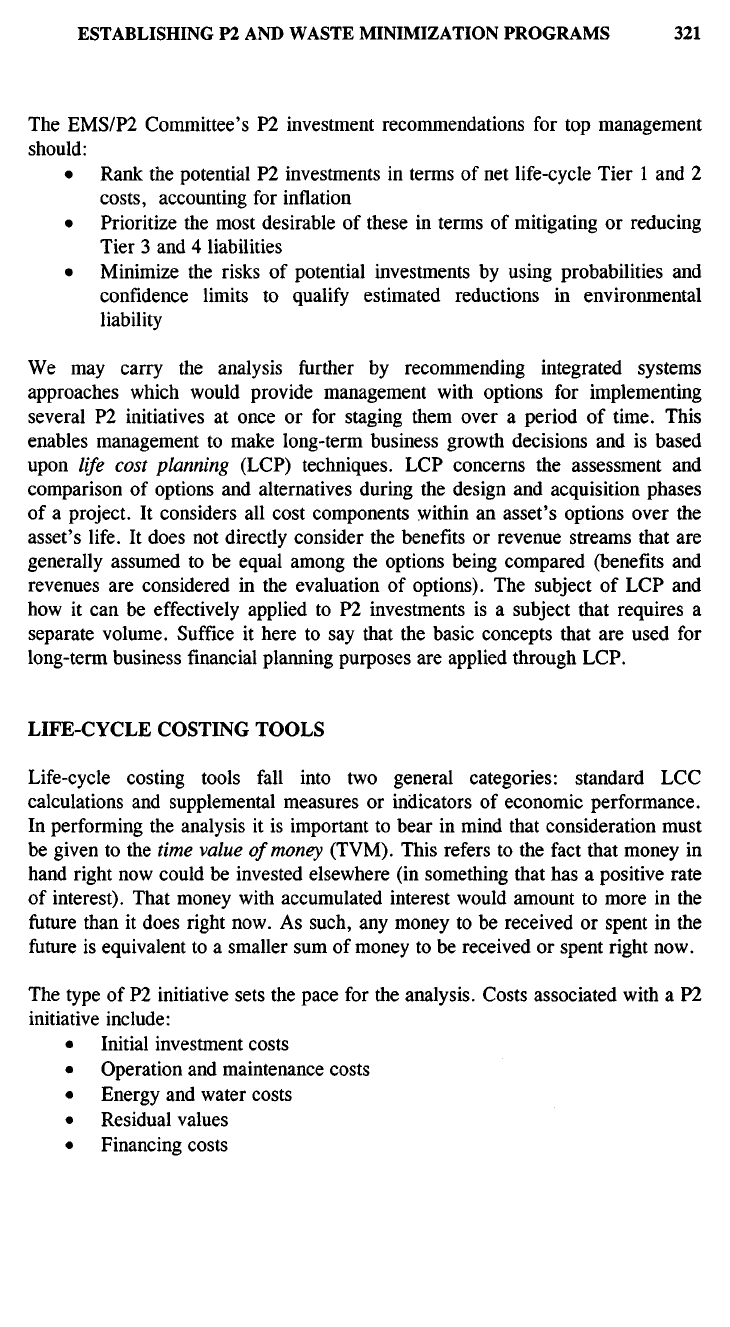
The EMS/P2 Committee's P2 investment recommendations for top management
should:
• Rank the potential P2 investments in terms of net life-cycle Tier 1 and 2
costs,
accounting for inflation
• Prioritize the most desirable of these in terms of mitigating or reducing
Tier 3 and 4 liabilities
• Minimize the risks of potential investments by using probabilities and
confidence limits to qualify estimated reductions in environmental
liability
We may carry the analysis further by recommending integrated systems
approaches which would provide management with options for implementing
several P2 initiatives at once or for staging them over a period of time. This
enables management to make long-term business growth decisions and is based
upon life cost planning (LCP) techniques. LCP concerns the assessment and
comparison of options and alternatives during the design and acquisition phases
of a project. It considers all cost components within an asset's options over the
asset's life. It does not directly consider the benefits or revenue streams that are
generally assumed to be equal among the options being compared (benefits and
revenues are considered in the evaluation of options). The subject of LCP and
how it can be effectively applied to P2 investments is a subject that requires a
separate volume. Suffice it here to say that the basic concepts that are used for
long-term business financial planning purposes are applied through LCP.
LIFE-CYCLE COSTING TOOLS
Life-cycle costing tools fall into two general categories: standard LCC
calculations and supplemental measures or indicators of economic performance.
In performing the analysis it is important to bear in mind that consideration must
be given to the time value of money (TVM). This refers to the fact that money in
hand right now could be invested elsewhere (in something that has a positive rate
of interest). That money with accumulated interest would amount to more in the
future than it does right now. As such, any money to be received or spent in the
future is equivalent to a smaller sum of money to be received or spent right now.
The type of P2 initiative sets the pace for the analysis. Costs associated with a P2
initiative include:
• Initial investment costs
• Operation and maintenance costs
• Energy and water costs
• Residual values
• Financing costs
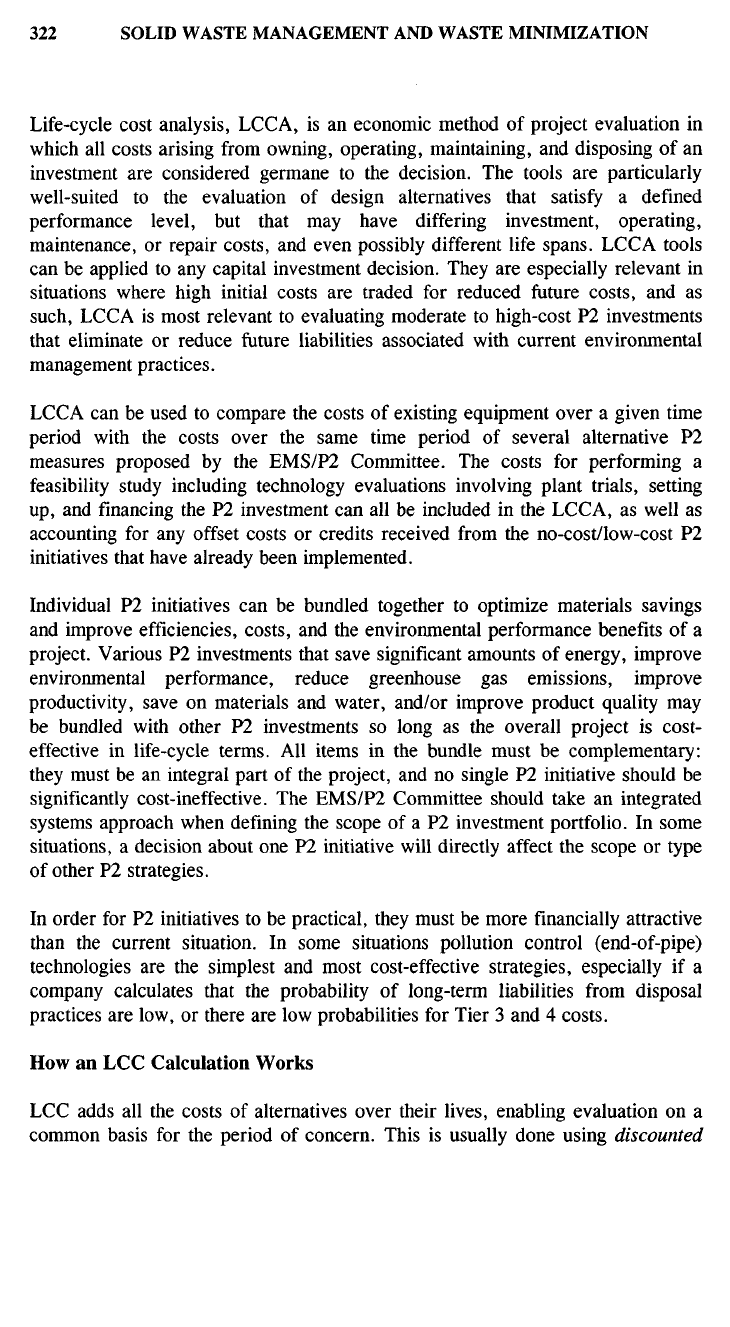
Life-cycle cost analysis, LCCA, is an economic method of project evaluation in
which all costs arising from owning, operating, maintaining, and disposing of an
investment are considered germane to the decision. The tools are particularly
well-suited to the evaluation of design alternatives that satisfy a defined
performance level, but that may have differing investment, operating,
maintenance, or repair costs, and even possibly different life spans. LCCA tools
can be applied to any capital investment decision. They are especially relevant in
situations where high initial costs are traded for reduced future costs, and as
such, LCCA is most relevant to evaluating moderate to high-cost P2 investments
that eliminate or reduce future liabilities associated with current environmental
management practices.
LCCA can be used to compare the costs of existing equipment over a given time
period with the costs over the same time period of several alternative P2
measures proposed by the EMS/P2 Committee. The costs for performing a
feasibility study including technology evaluations involving plant trials, setting
up,
and financing the P2 investment can all be included in the LCCA, as well as
accounting for any offset costs or credits received from the no-cost/low-cost P2
initiatives that have already been implemented.
Individual P2 initiatives can be bundled together to optimize materials savings
and improve efficiencies, costs, and the environmental performance benefits of a
project. Various P2 investments that save significant amounts of energy, improve
environmental performance, reduce greenhouse gas emissions, improve
productivity, save on materials and water, and/or improve product quality may
be bundled with other P2 investments so long as the overall project is cost-
effective in life-cycle terms. All items in the bundle must be complementary:
they must be an integral part of the project, and no single P2 initiative should be
significantly cost-ineffective. The EMS/P2 Committee should take an integrated
systems approach when defining the scope of a P2 investment portfolio. In some
situations, a decision about one P2 initiative will directly affect the scope or type
of other P2 strategies.
In order for P2 initiatives to be practical, they must be more financially attractive
than the current situation. In some situations pollution control (end-of-pipe)
technologies are the simplest and most cost-effective strategies, especially if a
company calculates that the probability of long-term liabilities from disposal
practices are low, or there are low probabilities for Tier 3 and 4 costs.
How an LCC Calculation Works
LCC adds all the costs of alternatives over their lives, enabling evaluation on a
common basis for the period of concern. This is usually done using discounted
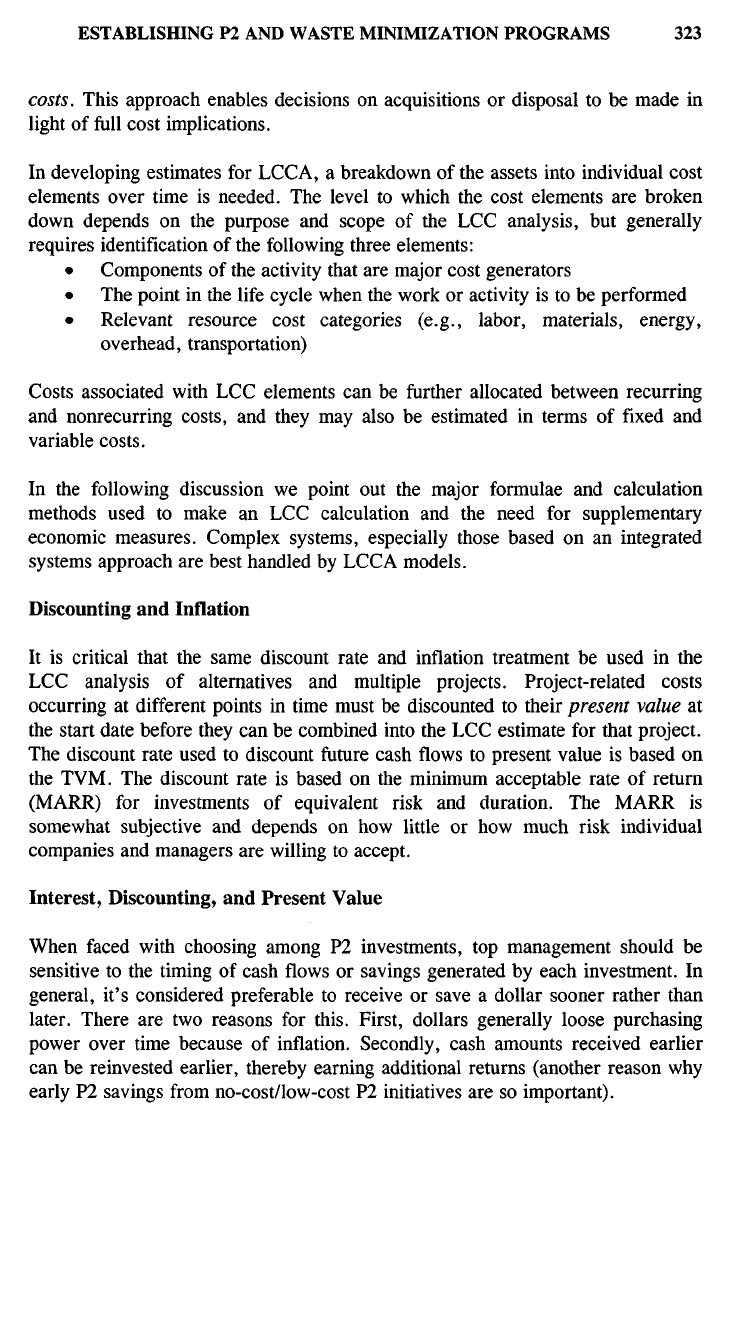
costs. This approach enables decisions on acquisitions or disposal to be made in
light of full cost implications.
In developing estimates for LCCA, a breakdown of the assets into individual cost
elements over time is needed. The level to which the cost elements are broken
down depends on the purpose and scope of the LCC analysis, but generally
requires identification of the following three elements:
• Components of the activity that are major cost generators
• The point in the life cycle when the work or activity is to be performed
• Relevant resource cost categories (e.g., labor, materials, energy,
overhead, transportation)
Costs associated with LCC elements can be further allocated between recurring
and nonrecurring costs, and they may also be estimated in terms of fixed and
variable costs.
In the following discussion we point out the major formulae and calculation
methods used to make an LCC calculation and the need for supplementary
economic measures. Complex systems, especially those based on an integrated
systems approach are best handled by LCCA models.
Discounting and Inflation
It is critical that the same discount rate and inflation treatment be used in the
LCC analysis of alternatives and multiple projects. Project-related costs
occurring at different points in time must be discounted to their present value at
the start date before they can be combined into the LCC estimate for that project.
The discount rate used to discount future cash flows to present value is based on
the TVM. The discount rate is based on the minimum acceptable rate of return
(MARR) for investments of equivalent risk and duration. The MARR is
somewhat subjective and depends on how little or how much risk individual
companies and managers are willing to accept.
Interest, Discounting, and Present Value
When faced with choosing among P2 investments, top management should be
sensitive to the timing of cash flows or savings generated by each investment. In
general, it's considered preferable to receive or save a dollar sooner rather than
later. There are two reasons for this. First, dollars generally loose purchasing
power over time because of inflation. Secondly, cash amounts received earlier
can be reinvested earlier, thereby earning additional returns (another reason why
early P2 savings from no-cost/low-cost P2 initiatives are so important).

When we invest a cash amount at a given interest rate, the future value of that
cash amount at any point in time can be computed using compound interest.
Consider than an initial sum of P
0
dollars is invested for t years at a rate of
interest, i, compounded annually. In one year, the yield would be iP
0
, which
when added to the principal, P
0
, gives:
P
1
= P
0
+ iP
0
= P
0
(I + i).
The future compound amount after t years would be:
P
t
= P
0
(I + i)\
Discount rates are essentially a special type of interest rate which makes an
investor indifferent between cash amounts received at different points in time. An
investor would just as soon have one amount received earlier as the other amount
received later.
Calculations involving discounting are identical to those of compound interest.
The discount rate, d, is used like the interest rate, i, to determine the present
value (PV) of a cash amount received or paid at a future point in time. The PV of
a future amount received at the end of year t, F
t
, is calculated as follows:
PV = F
t
/(1 + d)
!
.
Note that costs that occur at different points in time over the life of the
investment cannot be used directly in the LCC calculations because the dollars
spent at different times have different values to the investor. These costs must
first be discounted to their present-value equivalent amounts. Only then can the
costs be added into the analysis to yield a meaningful LCC that can be compared
with the LCC of other P2 investments or the current situation.
The Importance of Inflation
Inflation reduces the purchasing power of the dollar over time (conversely,
deflation increases it). When future amounts are stated in actual prices as of the
year in which they are expected to occur, they are said to be in current dollars.
Current dollars are dollars of any one year's purchasing power, inclusive of
inflation. In other words, they reflect changes in purchasing power of the dollar
from year to year. In contrast, constant dollars are dollars of uniform purchasing
power, exclusive of inflation. Constant dollars reflect what the same good or
service would cost at different times if there were no change in the general price
level (i.e., no general inflation or deflation). In other words, there is no change
in the purchasing power of the dollar.

The discounting of future cash flows to present value is not the same as adjusting
future costs for general inflation. Even when costs are expressed in terms of
constant dollars, they must be discounted to reflect the TVM, which is usually
greater than the rate of inflation. A discount rate used with constant-dollar
amounts is different than from the discount rate used with current-dollar
amounts. A real discount rate (net of general inflation) should be used with
constant-dollar amounts. A nominal discount rate (inclusive of general inflation)
should be used with current-dollar amounts.
Cost Categories
There are several ways of classifying the cost components in LCCA. The most
important ones to distinguish among are:
• Investment-related and operational costs
• Initial and future costs
• Single costs and annually recurring costs
LCC for P2 includes both investment costs and operational costs. The distinction
between the two is most useful when calculating economic measures such as the
savings-to-investment ratio (SIR) and the adjusted internal rate of return (AIRR).
These economic measures evaluate savings in operation-related costs which
generally are most critical for Tier 1 and 2 components. The SIR and the AIRR
are measures that evaluate savings in operation-related costs with respect to
capital investment costs. This distinction does not affect the LCC calculation
itself,
nor will it cause an investment alternative to change from being cost-
effective to non-cost-effective or vice versa. However, it may change its ranking
relative to other independent projects when allocating a limited capital investment
budget.
When a company considers these elements, it should consider all acquisition costs
- those associated with planning, design, purchase, and construction - investment-
related costs. It should also take residual values (based on the value in place,
resale value, salvage value, or scrap value, net of any selling, conversion, or
disposal costs) and capital replacement costs into account in the investment
calculus. Capital replacement costs are incurred when replacing major systems or
components (a major upgrade on aeration tanks in a wastewater treatment plant,
for example), and they must be paid for from capital funds. Operating,
maintenance, and repair (OM&R) costs should include energy and process water
costs.
These are operational costs. Replacements that are related to maintenance
or repair are also considered OM&R costs, not capital replacement costs. OM&R
costs are best paid for from an annual operating budget and not from capital
funds.

The distinction between initial investment costs and future costs is most
appropriate when calculating simple or discounted payback indicators. Costs
incurred in planning, design, construction, and/or the acquisition phase of a P2
investment can be classified as initial investment costs. These costs occur before
a system or piece of equipment is placed into service. Costs that arise from the
operation, maintenance, repair, replacement, and use of the equipment or system
during the life of the operation are future costs. Residual values at the end of the
system life, or at the end of the study period for the evaluation, are also future
costs.
This brings us to single costs versus annually recurring costs. The distinction
between these two determines the type of present-value factor most appropriate
for discounting future cash flows to present value. Single costs are one-time
costs.
They occur at one or more times during the evaluation period (life of the
investment) at non-annual intervals. Examples of single costs are initial
investment costs, and replacement costs scheduled at intervals longer than 1 year.
Repair costs may also be considered as single costs. The proper discount
formulas to use in LCC are given in Table 4. In this table are included
subformulas which can be used to compute a corresponding discount factor. The
computed discount factor is a number by which an amount is multiplied to obtain
a present value. For discounting one-time amounts to present value, the single
present value (SPV) factor is used. The reader can find SPV factors in a number
of LCC references (one we recommend is the Life-Cycle Costing Manual for the
Federal Energy Management Program by S. K. Fuller and S. R. Petersen, U.S.
Department of Commerce, NIST Handbook 135, 1995 edition).
Table 4. Present-Value Formulas and Subformulas Using Discount Factors
Formula application
PV formula for one-
time amounts: The
SPV factor is used to
calculate the PV of a
future cash amount
occurring at the end of
year t, F
n
given a
discount rate, d.
PV formula for
annually recurring
uniform costs: The
UPV factor is used to
calculate the PV of a
Formula
PV = F
t
x 1/(1 + d)
1
PV = A
0
x 1/(1 + d)
c
=
A
0
X
[{(1 + tf)
n
-l}/rf(l
Subformula
with discount factor
PV = F
t
x SPV^
Note: Use standard
discount tables for
values of the SPV
factor. As an example,
the SPV factor for d =
3%
and t = 15 years is
0.642.
PV = A
0
x UPV
M
Note: Use standard
discount tables for
values of the UPV
